Heirophant - Heh
The high priest calmly sits upon his throne. The papal mitre rests upon his sacred head. Two pillars arise from the back of his throne, as his left hand firmly grasps the royal sceptre of power. He signals his commands with his right hand, as what appear to be two youths of lower rank stand in front of him. In the Noblet version of the Tarot de Marseilles, the one to the left side of the image has open hands and a hat, while the one to the right appears to have his hands clasped together in prayer and has no hat at all.
The name of the fifth character of the ancient alphabet is linked to the fifth hieroglyphic symbol of the Tarot. The original design of this character (pre-1200 B.C.) looks like this...
![]()
This letter (whose mirror image is identical to the uppercase letter E) is the precursor to the modern letter E. The name of this character is הא. The most fundamental meaning of this name is that of "look!" as an exclamation. Derivations from this primary meaning of vision include “lo,” and “behold.” The correlation of this meaning to the visual aspect of Ra (the Egyptian god of the sun, whose symbol was the eye) and the entire diurnal concept of "flowing" that is an integral component of the Apollonian ideal.
Therefore, the basic essence of this iconic hieroglyph is that is of the use of the visual. Since this energy patterns its basic nature from that which is perceived by the eyes, it does not generally require a high amount of sensitivity to the nocturnal vibratory energies of Venus and Jupiter. The central figure in this iconic image wields the royal sceptre of power in the left hand; therefore, it would seem logical to assert that he maintains the high degree of emotional management necessary to rule efficiently by correctly balancing the feminine nocturnal currents.
The Lesser Minions of the Marseilles Pope Trump
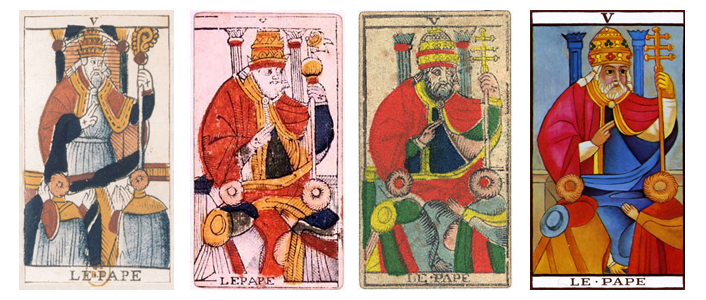
There is one primary reason why the two lesser minions depicted in the lower part of the image of this Tarot trump are in their current state of inferiority. They do not possess the physical matter necessary to balance the emotional currents of the left-hand side - i.e. they do not have hair of sufficient length that is necessary to perform this task. Since most of an individual's body heat escapes through the head, cutting the hair greatly reduces the amount of heat and energy present within the body and makes it work harder to maintain its correct temperature. This debilitating physical condition keeps the sheared minions bound in an inferior state of existence and cause them to be less sensitive to the vibratory essence, so they will be more responsive to the commands of their leaders. However, the figure on the left side of the image on the right hand side of the hierophant, does have a hat that will help somewhat with this physical deficiency. Due to this aid, this lesser figure seems to be having a divine revelation similar to the central character (the Hanged Man) of the 12th hieroglyphic icon of the Tarot (as depicted in the Noblet version of the Marseilles Tarot), as the hat helps to retain heat within the sheared head of this lesser pawn of the empire, which helps to increase the amount of heat that is present within his body.
Therefore, one of the interesting features of this image that is exclusive to the Noble deck is the placement of the hands of the two lesser minions. In the later decks, all four hands are not always visible, and when they are, their gestures with their hands are uncertain. However, in the Noblet version, the hands of the minion on the left of the image appear to be in some type of opened position, as if this individual is experiencing some type of epiphone, while the hands and face of the other on the right appear to be clasped together in prayer as his head in bowed in reverence. Thus, the opened hands of the minion on the left that possesses a hat could be further representation of some type of divine revalation that is possible due to the enhanced kundalini energies within his system because of the heat retained in the head by the hat.
The Hierophant of the Rider-Waite Deck
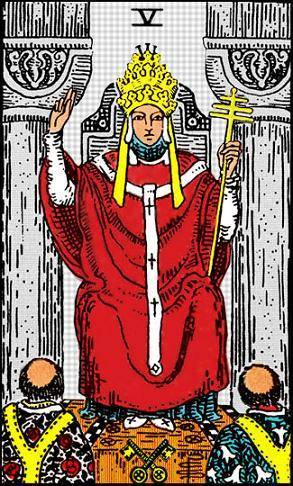
Waite comments about this particular trump in the accompanying text to the Rider-Waite Tarot, “He wears the triple crown and is seated between two pillars, but they are not those of the Temple which is guarded by the High Priestess. In his left hand he holds a sceptre terminating in the triple cross, and with his right hand he gives the well-known ecclesiastical sign which is called that of esotericism, distinguishing between the manifest and concealed part of doctrine. It is noticeable in this connexion that the High Priestess makes no sign. At his feet are the crossed keys, and two priestly ministers in albs kneel before him. He has been usually called the Pope, which is a particular application of the more general office that he symbolizes. He is the ruling power of external religion, as the High Priestess is the prevailing genius of the esoteric, withdrawn power. The proper meanings of this card have suffered woeful admixture from nearly all hands. Grand Orient says truly that the Hierophant is the power of the keys, exoteric orthodox doctrine, and the outer side of the life which leads to the doctrine; but he is certainly not the prince of occult doctrine, as another commentator has suggested. He is rather the summa totius theologiæ, when it has passed into the utmost rigidity of expression; but he symbolizes also all things that are righteous and sacred on the manifest side. As such, he is the channel of grace belonging to the world of institution as distinct from that of Nature, and he is the leader of salvation for the human race at large. He is the order and the head of the recognized hierarchy, which is the reflection of another and greater hierarchic order; but it may so happen that the pontiff forgets the significance of this his symbolic state and acts as if he contained within his proper measures all that his sign signifies or his symbol seeks to shew forth. He is not, as it has been thought, philosophy-except on the theological side; he is not inspiration; and he is not religion, although he is a mode of its expression.”
* * *
BACK * INDEX * NEXT
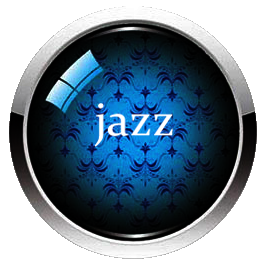 |
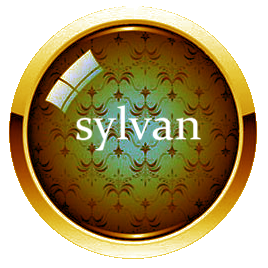 |
 |
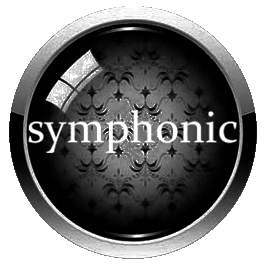 |
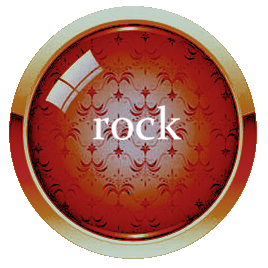 |
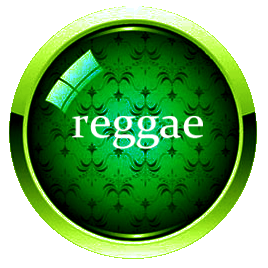 |